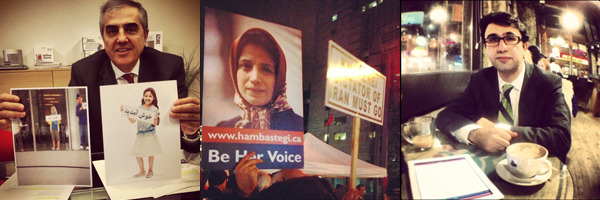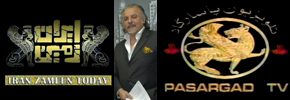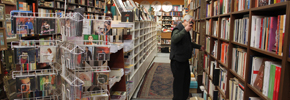Sima Sahar Zerehi – It’s that time of year; for a brief moment we are self-reflective about what we accomplished in the past 365 days. What did we learn? How did we grow? Who did we impact and what can we take away from our trials and tribulations for the year to come.
As a community, we have had a difficult year in some ways. In 2012 Iran was the subject of many headlines, but seldom did the corresponding stories deliver anything but bad news. The narratives of the resistance and struggle of average Iranian students, workers, artists, academics, and activists fighting bravely against the Islamic regime that had temporarily occupied the front pages of news sites after the 2009 fraudulent Iranian election completely faded away. They were once again replaced with news about the Islamic regime’s nuclear ambition, its aid to Assad’s regime in Syria and its acts of atrocity through its campaign of social and political oppression, censorship, imprisonment, rape and torture.
Iran, the boogie monster
Foreign governments including the Canadian government responded by labeling Iran as a threat to global peace. While little attention was paid to Iran’s human rights violations, much was made of Iran’s prospects of engaging in an unlikely war with Israel. Diplomatic relations were severed and debilitating economic sanctions were placed on Iran.
In the wake of sanctions Iran is faced with a rapidly declining economy and an internal power struggle dividing its once united religious and political leaderships.
Caught in the grind are average Iranians, crippled by a rapidly devaluating rial, empty grocery store shelves and inflated prices out of reach for most working-class families, not to mention a tyrannical government that doesn’t hesitate to make examples of anyone daring to speak out against it.
Free Nasrin Sotoudeh
In these dark times we have had some bright moments. We have seen Nasrin Sotoudeh, a prominent human rights lawyer and women’s rights activist, who represented Nobel Peace Prize laureate Shirin Ebadi amongst her many clients, become a household name for Iranians.
Her strength of conviction and integrity of principles have elevated her to the position of an international hero for women’s right and human rights activists.
In a country where lawyers are arrested alongside their clients, Sotoudeh chose to not only remain in Iran but also to continue to serve as legal council for clients others didn’t dare to represent.
Sotoudeh was arrested in September 2010 on charges of spreading propaganda and conspiring to harm state security and was imprisoned in solitary confinement in Evin Prison. She was sentenced to 11 years in prison in January 2011. In addition she was barred from practicing law and from leaving the country for 20 years. Later an appeals court reduced her prison sentence to six years, and her ban from working as a lawyer to 10 years.
In jail Sotoudeh embarked on two hunger strikes. On September 25, 2010, she began a 4-week-long hunger strike to protest being denied visits and phone calls from her family. Once again on October 17, 2012 she began an indefinite hunger strike in protest of new restrictions placed on her family including a travel ban against her daughter.
After 49 days and deteriorating health conditions, Sotoudeh stopped her strike when her request for lifting her daughter’s travel ban was granted.
In many ways Nasrin Sotoudeh changed the image of the Iranian woman in the eyes of international media. Unlike other women in the headlines victimized by the Islamic regime, Sotoudeh was not a passive agent; she is educated, articulate, politically savvy, and acutely aware of the risks she takes in the name of women’s and human rights. Sotoudeh is a new kind of hero, the kind of woman activist that will ultimately defeat the tyranny of the Islamic regime’s misogynistic grip on the country.
Closer to Home
While it’s been a challenging year to be an Iranian, the Iranian-Canadian community in Toronto has been able to celebrate a few significant victories in 2012.
We have shown that we are maturing as a community; we are better organizers and more polished advocates with a slew of emerging young talents stepping up to the plate as new leaders.
Iranian Canadian Congress Gets a New Facelift
“The ICC was an institution that was created a few years ago precisely with the intention of giving the community political and social power, but unfortunately it had been underutilized,” begins Kaveh Shahrooz, the new Vice President of the Iranian Canadian Congress, about why he decided to get involved in this largely dormant community organization by running for the position of VP in their last AGM in April.
Shahrooz is one of those go-getter-types, a Harvard graduate and practicing lawyer, with a background in human rights policy and a new baby on the way. Dressed up in his now trademark suit and tie, he appears campaign-poster-perfect.
In fact he looks much the same as he did last April during the ICC annual general meeting at the North York Civic Centre. On that day a record number of people had showed up to vote, and to renew their interest in the ICC as a flagship community organization, there was a real buzz about Shahrooz’s candidacy.
When he took to the podium for his speech, I realized what all the fuss was about. Shahrooz was articulate, passionate, determined and sharp. He didn’t shy away from critical questions and handled the event like a pro. If the ICC AGM was his audition for the position of the new Tehranto spokesperson, he was met with critical acclaim. The crowd loved him and to his credit he treated them with reverence and respect appropriate for someone re-entering the community after a few years of being away.
Since taking up the position of VP, Shahrooz has dramatically reinvigorated the ICC. In a few short months the organization has become a real mouthpiece for the community. Launching critical campaigns such as the campaign against TD Bank and representing Iranian-Canadians on key issues like the closure of the Iranian embassy in Ottawa.
With Shahrooz at the helm the ICC has taken on new relevance and respectability.
Speaking of his work with the ICC since April, Shahrooz explains, “There’s been two sets of things simultaneously happening. One is outwards facing which is actually about being part of the larger Canadian discussion about our community,” he begins and adds, “In order for our community to be relevant we have to be engaged in a sustained conversation with the Canadian media, with Canadian civil society, with other ethnic groups, with every political party, and every institution that has power in this country, and we have to approach that smartly and show that we are an incredible community that has political weight that can use its influence effectively.”
“The other part of the work is about building the institution and building the infrastructure,” Kaveh notes, “work that includes building our ties with our new and existing members, increasing our membership and solidifying our base through better communication strategies and more transparent procedures.”
Speaking of the ICC successes Shahrooz recounts that on the day of the ICC AGM the Canadian government announced the closure of their visa offices in Tehran.
“We decided to immediately spring into action, we did some fact finding, we talked to immigration experts and tried to figure out what the issued were,” explains Shahrooz.
“As a result we decided to launch a letter-writing campaign to Minister Kenney to let him know that we were displeased with his decision and that if this was part of the sanctions regime it wasn’t hurting the government, it was hurting ordinary people. We emphasized that we were a community, and we are voters and we have a long memory.”
Shahrooz states that although they were unable to reopen the visa offices, the campaign did have an impact.
He states “The Minister was very aware that it was being inundated with hundreds upon hundreds of letters from the community and there was a recognition in the Minister’s office that the Iranian community can be mobilized when they make decisions that affect us and I think in the future they will be consulting with us much more closely.”
Shahrooz also points to the TD Bank campaign in response to the bank closing down accounts belonging to Iranian Canadians without due notice.
“Once again we started with fact finding, instead of acting upon rumors we decided to act based on well thought out analysis, we took our case to both the elected officials as well as the Canadian media, it was the perfect storm of a story where there was a grievance against an institution that the media cares a lot about and suddenly within the span of three days we were doing interviews with all the national media as well as some international media such as the BBC,” explains Shahrooz.
“Within a few days we got the attention of the bank, we had a fruitful meeting with them, we didn’t get them to reverse their decision but we did get them to acknowledge the grievance within our community and to revisit some of the mechanisms they used,” states Shahrooz.
Speaking about lessons learned, Shahrooz notes, “What we learned as a result is that the sanctions regime has some ambiguities that we need to work on, not necessarily with TD but within the political process.”
In response to the criticism that some ICC positions might be seen as support for the Islamic regime, Shahrooz states, “Our position has been very clear, it is one that we voice at every media interview and a position that we presented when we appeared before the Senate.”
“We believe that Canadian relations with Iran should be first and foremost human rights focused, that means that if the Canadian government wants to impose sanctions on Iran the policy has to be geared to getting the Iranian regime to improve its human rights. When you punish the Iranian regime or people directly connected to the regime we don’t have a problem with that as an institution, we do have a problem when the impact of those policies aren’t felt by the people connected to the regime they are felt by ordinary people. Put as much pressure as you like on the Iranian regime but leave ordinary people alone.”
Shahrooz concludes by talking about his extremely ambitious short and long-term goals for the ICC.
“In the short term I want to make sure that our organization has a broad membership across the city and across the country. I’d like to ensure that as a result of that we get good advice and insight from cross-sections of the community regarding our positions and campaigns. We also need to built the financial capacity to lobby the government and mount campaigns.”
“In the long term I want the ICC to be a powerful voice in the Canadian debate about what we want this country to look like,” asserts Shahrooz.
He concludes, “I don’t want our community to be ghettoized, I don’t want us to be inward looking and insular, I want us to be actually participating in the larger Canadian discourse about the future of this country. I think that will require some rethinking and repositioning for our institution, we will need to be less focused on what happens in Iran and be more Canada focused.”
The GTAA Child Ambassador Campaign
Sometimes looking at a single modest campaign spearheaded by a concerned citizen tells you volumes about the state of a community.
“I’m a businessman so I travel a lot and I go through Pearson airport’s terminal 1 quite often,” begins Mr. Reza Banai, the president of C-Living Inc., a successful contemporary interior design product developer, about how he became the main organizer of a successful campaign to change a Farsi language welcome sign at the Toronto airport featuring a young girl wearing a veil.
The sign was part of an advertisement campaign initiated by the Greater Toronto Airport Authority to promote Toronto as a multicultural hub. The campaign features a number of children from various ethnic backgrounds holding up welcome signs in various languages.
“When I noticed these new signs, the first thing that came to my mind was, there are all these children from all these nationalities and the only one that is wearing a hijab is the one with the Farsi sign,” explains Mr. Banai a well-spoken middle-aged man with salt and pepper hair, a smartly tailored a suite and a warm inviting smile. Mr. Banai seems like the kind of guy who would be anyone’s favourite uncle, and he has a flair for story telling, as all good uncles should.
“I asked myself who is the audience for these signs and I concluded that predominantly the audience was people travelling to Toronto to visit friends and family and those residing in Toronto, as the sign is written in Farsi you can assume that the specific audience are Farsi speaking travelers or residents from the Iranian community,” deduced Banai.
“It came to my mind, is the image of a girl in a hijab a close representation of this Iranian-Canadian population that includes new immigrants and international students?” asked Banai.
“We know for a fact that the majority of Iranians in Canada who are either citizens or residents do not wear the hijab. When you go to community events it becomes immediately obvious that those who wear the hijab are extremely rare,” explains Banai.
“Even putting the political issues and any anti-regime sentiments to the side, the first thing that comes to mind is that this image is not an accurate representation of Iranian-Canadians,” concludes Banai.
“I was also talking to some of my friends, a lot of people in the community, who had also noticed the signs and were concerned by the image, so one day I decided to take action,” recounts Banai.
Banai decided that the best course of action was not to jump into an adversarial position against the GTAA and involving the media. He decided that he would first attempt to initiate a dialogue with those responsible to see if they were open to making the changes in light of community concerns.
In May 2012 Banai tried to contacted Pearson Airport authorities and was surprised to find that it was impossible to find someone on the other side of the phone.
While most people of his generation would have given up at this point, Banai persevered.
“Everything is online these days, so I drafted a letter, consulted with lawyers because I knew I was touching on something sensitive and I didn’t want to make any comments that would have any legal consequences, I wanted to make sure we were not undermining any ethnic group or beliefs,” states Banai.
The resulting letter was a professionally crafted correspondence that identified Banai and his fellow campaign members as a group of concerned Canadian citizens with Iranian heritage.
Banai notes “if the sign is intended for me or other Iranian-Canadians like me than firstly the wording has to be edited as the welcome message is written incorrectly in the past tense rather than in the present tense, and the image should be altered to reflect the realities of the current population of Iranian-Canadians living in Canada.”
In addition to the letter, Banai also erected an online campaign that included an electronic petition circulated via email and Facebook to demand that the GTAA alter the sign.
Within a few days the campaign attracted the attention of hundreds of supporters who added their name to the list of opponents.
Banai’s letter received a reply from the GTAA’s General Manager of Brand Development, Paul Kopas, who assured him that he was willing to meet to discuss the issue with Banai and others.
“Two or three days prior to our meeting in early July I received another email from Mr. Kopas who informed me that they had conducted their own internal investigation and were prepared to change the text and image to best fit the context where it is displayed and the reality of the Iranian-Canadian community,” explains Banai.
I this point Banai brandishes a huge smile and says, “mission accomplished.”
Banai is no stranger to social activism, he’s a regular financial supporter of human rights campaigns in Canada, often footing the bill for travel expenditures allowing young students to partake in actions like the 2009 hunger strike in front of the United Nations building in support of imprisoned activists in Iran. He’s a fixture at community gatherings and events but always as a face in the crowd.
This time Banai decided to lead by example and mount a professional campaign based on the principles of dialogue and democratic involvement. He didn’t play the typical role of the angry marginalized immigrant futilely waving a placard in a remote location unseen by decision makers and media outlets. He acted strategically as befitting a man who has experience, education and money at his disposal. Most of all he acted with a sense of entitlement – in the best sense of the world, entitlement that comes to any citizen demanding to be heard and respected.





